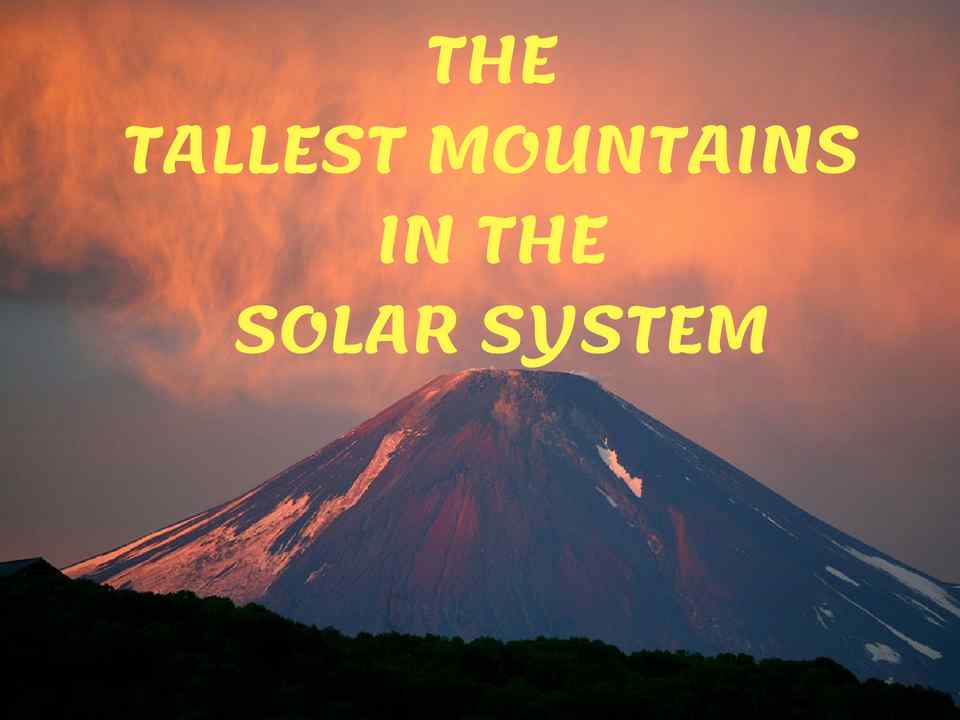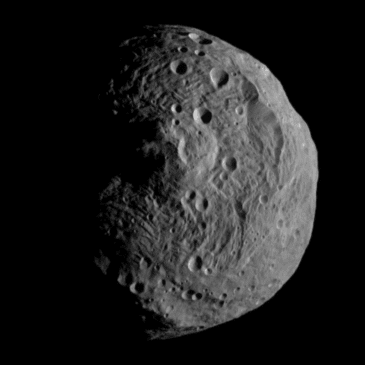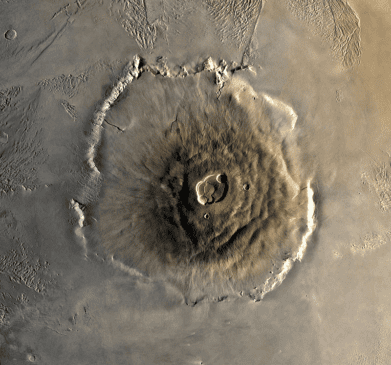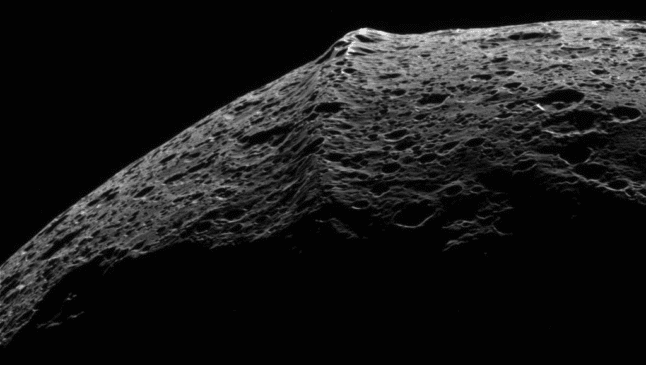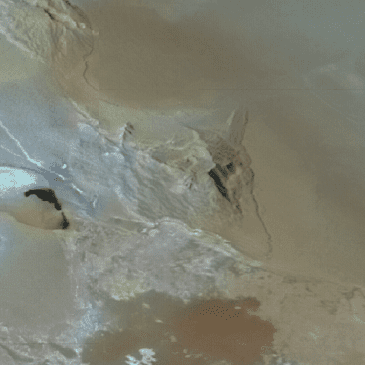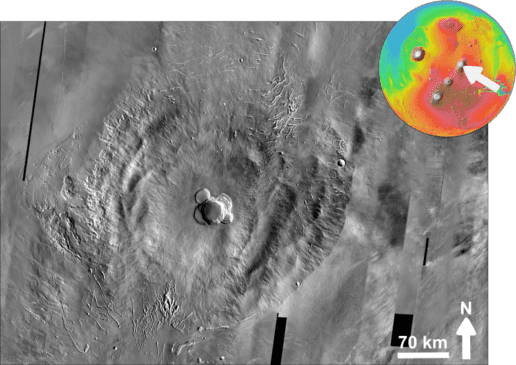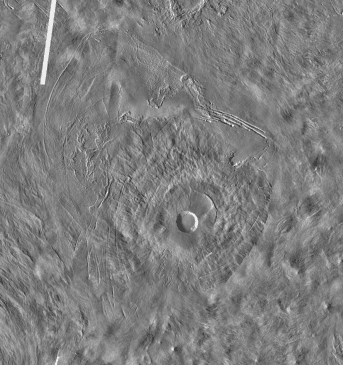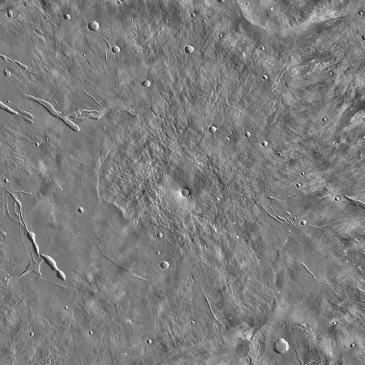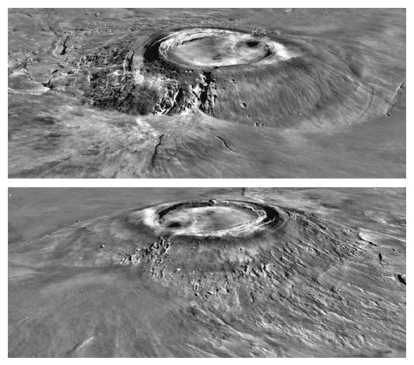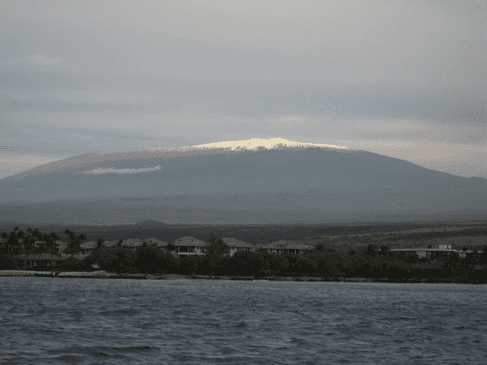All of us have heard about Mount Everest, which is the tallest mountain on planet Earth when height is measured from sea level. Have you thought about the tallest mountains in our solar system which consists of 8 planets, 5 dwarf planets and many comets, asteroids, meteoroids, and moons? Most of the tallest mountains in the solar system are located on red planet Mars.
Read on to know the 11 tallest mountains in the Solar System.
1. Rheasilvia Mons, 4 Vesta – 22 km (14 mi)
The mountain is located in asteroid 4 Vesta and lies in the middle of a crater 300 miles wide. With a height of 22 km from its base, Rheasilvia Mons gets the first spot in tallest mountains in the solar system. It was discovered in 2006 and was named in 2011 after Rhea Silvia, a mythological character who was the mother of the founders of Rome. Rheasilvia is the most prominent surface feature on the asteroid 4 Vesta which is the second largest body in the asteroid belt after the dwarf planet Ceres. A spacecraft named Dawn studied the asteroid closely in the year 2012 before moving onto Ceres in 2015. Rheasilvia Mons is the tallest non-planetary mountain in the solar system.
In part, the crater conceals a former crater, Veneneia, which is almost as large at 395 km (245 mi).
The crater floor is about 13 kilometres (8.1 miles) below the surrounding surface. There is an escarpment around part of the perimeter of Rheasilvia, rising from 2.5 to 12 kilometres (2.5 to 7.5 mi) above the surrounding terrain. The basin consists of undulating terrain and a central mound measuring nearly 200 kilometers in diameter, which rises 20–25 kilometers from its base and may have formed from a planetary scale hit.
Divalia Fossa is approx. 22 km wide and 465 km long and is thought to be a large-scale fracture resulting from the impact in Vesta’s equatorial region.
According to estimates, the collision excavated approximately 1% of Vesta’s volume, which explains the origins of Vesta’s family of asteroids and its V-type asteroid. The survival of fragments of about 10 km up to the present shows that the crater must be about a billion years old. It could also explain HED meteorites’ origin. About 6% of the mass is made up of known V-type asteroids, while the rest is likely either too small to observe or disappeared due to radiation pressure.
2. Olympus Mons, Mars -21.8 km (13.6 mi)
Olympus Mons is located on planet Mars and it is a second highest mountain in the solar system and the tallest mountain in 8 planets of the solar system. It stands about approx 2.4 times tall of Mount Everest’s height (8848 m) above sea level. In diameter, Olympus Mons is the size of Arizona. It is also the youngest of the large volcanoes on Mars. Mons is also reported to be the largest volcano in the solar system. Olympus Mons is situated near three volcanoes known as the Tharsis Montes. It was discovered in 1971 and it was the tallest mountain in the solar system for 40 years until Rheasilvia Mons was discovered.
3. Equatorial Ridge, Saturn’s Moon Iapetus– 20 km (12.4 mi)
Equatorial Ridge is located at Iapetus, third largest moon of Saturn. Iapetus is named after the Titan Iapetus, suggested by John Herschel. It has a big crater which makes the moon look like the Death Star of Star Wars. 20 kilometer high ridge is running along most of the equator of Iapetus. The ridge was discovered by the Cassini probe in 2004. Mountain Peaks in the equatorial ridge rise around 20 km above the surrounding plains, making them some of the tallest mountains in our Solar System. There are several theories on the ridge’s formation, however, none has been confirmed. The most popular theories are that it may have been either the leftover of an oblate moon, icy material thrust up from beneath the moon’s surface or it may have been part of a collapsed ring.
4. Boösaule Montes, Jupiter’s moon IO – 17.5 km (10.8 mi)
Boösaule Montes is located in Io, the fourth largest and innermost moon of Jupiter. Most of the tallest mountains in the solar system are volcanoes, but this one is not. In fact, Boösaule Montes is the tallest non-volcanic mountain in the solar system. This mountain is named after a cave where Epaphus (son of Zeus) was born as per Greek Mythology. South Boösaule has a relative height of 18.2 km. The height from the mountain base is 17.5 km. The mountain’s steep side has a 40-degree slope which according to scientists may have been the result of a massive landslide.
5. Ascraeus Mons, Mars – 14.9 km (9.3 mi)
Ascraeus Mons is the second largest mountain on planet Mars (after Olympus Mons) reaching about 15 km from its base with a 2.1 miles deep central caldera. It was discovered by the Mariner 9 spacecraft in 1971. Ascraeus Mons is a very large shield volcano located in the Tharsis region of the planet Mars. Ascraeus is the northern one and tallest of three shield volcanoes which are collectively known as the Tharsis Montes. The volcano was initially known as North Spot because it was the located northernmost of four spots visible on the planet surface due to a global dust storm that surrounded the planet at that time. As the dust cleared, the spots were revealed to be extremely tall volcanoes and Ascraeus Mons got its name.
Image Credit: NASA/JPL/Malin Space Science Systems
6. Pavonis Mons, Mars – 14 km (8.6 mi)
Pavonis Mons is a large volcano located in the Tharsis region of the planet Mars where three large volcanoes are present. It is the middle member of a group of three volcanic mountains collectively known as the Tharsis Montes. Pavonis Mons is located next to another tallest mountain Ascraeus Mons. The volcano was discovered by the Mariner 9 spacecraft in 1971 and was originally called Middle Spot because it was the middle of the spots visible on the surface. It was officially named Pavonis Mons in 1973 and several studies suggest that glaciers might be present there. The name “Pavonis Mons” translates to the peacock’s mountain.
7. Elysium Mons, Mars – 12.6 km (7.8 mi)
Elysium Mons is a large volcano located in the volcanic province of Elysium in the eastern hemisphere of planet Mars. It stands about 13.9 km above the surrounding lava plains. Elysium Mons was discovered from images returned by the Mariner 9 orbiter in 1972. At the bottom of Elysium Mons are two other volcanoes: Hecates Tholus to the northeast, and Albor Tholus to the southeast. Elysium Planitia, a flat plain just north of the Mars equator makes for the perfect location to study the deep interior of planet Mars.
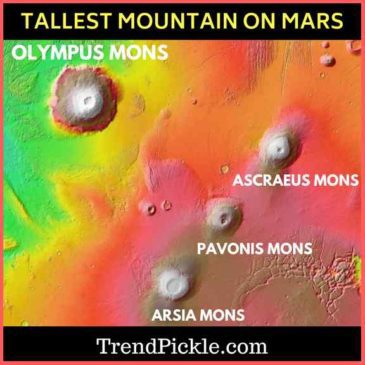
8. Arsia Mons, Mars – 11.7 km (7.3 mi)
Elysium Mons is a large volcano located in the volcanic province of Elysium in the eastern hemisphere of planet Mars. It stands about 13.9 km above the surrounding lava plains. Elysium Mons was discovered from images returned by the Mariner 9 orbiter in 1972. At the bottom of Elysium Mons are two other volcanoes: Hecates Tholus to the northeast, and Albor Tholus to the southeast. Elysium Planitia, a flat plain just north of the Mars equator makes for the perfect location to study the deep interior of planet Mars.
9. Oberon Peak, Uranus – 11 km (6.8 mi)
It is the second-largest Uranian moon. It was discovered in 1787 by William Herschel. It is named after a character that appears in Shakespeare’s play A Midsummer Night’s Dream. Uranus’s magnetosphere extends partially outside its orbit. There is an equal amount of rock and ice on the moon, and the two parts are probably differentiated.
Oberon Peak on Uranus
10. Maxwell Montes, Venus – 11 km (6.8 miles)
It is located on Ishtar Terra, Venus’ northern most highland and stretches for 530 miles. Scientists don’t know how these mountains formed on Venus, but they believe they contain large amounts of iron pyrite.

Maxwell Montes on Venus
11. Mauna Kea, Earth – 10.2 km (6.3 miles)
Mauna Kea is a dormant volcano on the island of Hawaii. The Mauna Kea stands 4,207 meters above sea level and its peak is the highest point in the state of Hawaii. Measured from sea level, this mountain is 4.2 km tall but if we measure from the oceanic base of the mountain, Mauna Kea is the tallest mountain on planet Earth. Most of the mountain is underwater and thus when measured from its oceanic base, Mauna Kea is over 10 km tall and is the tallest mountain on planet Earth.
Did you like the story? Please share with your friends.

